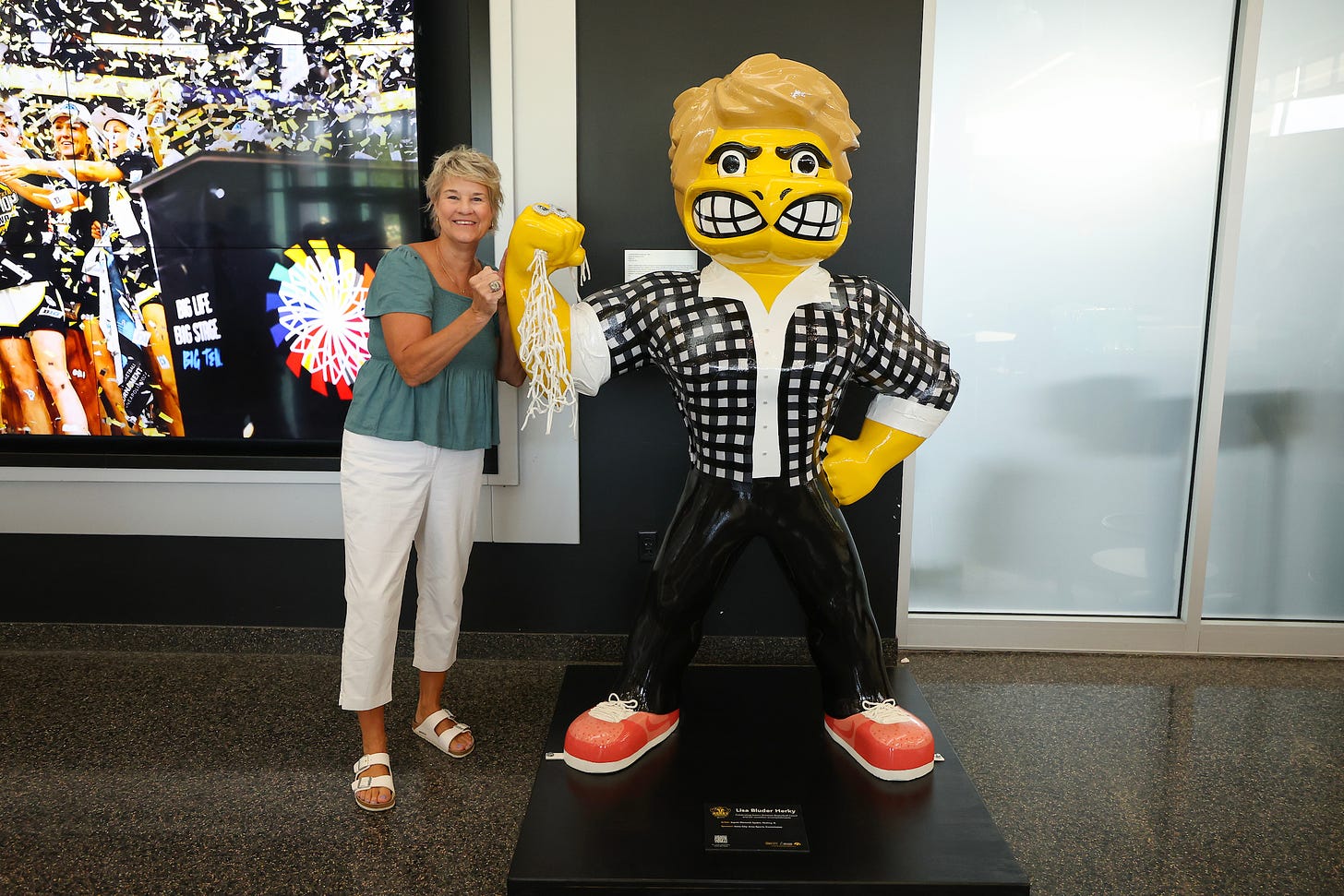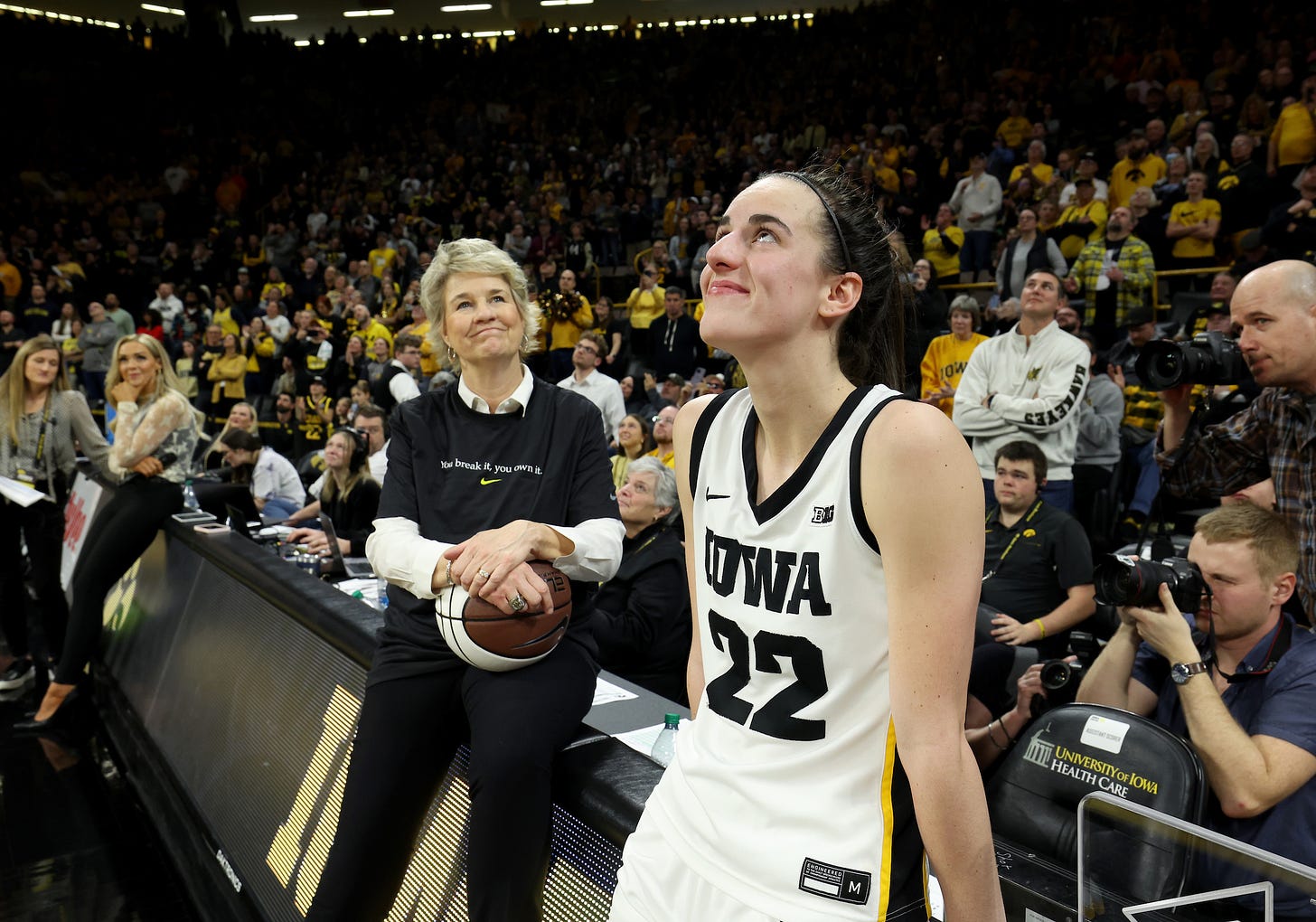From an empty office to jam-packed arenas, Lisa Bluder's career had it all
In the second part of an interview, former Iowa coach reflects on an ever-changing sport and a once-in-a-lifetime player

The arc of Lisa Bluder’s career in basketball can be summed up in one concise four-letter word.
No, not that kind of four-letter word. Get your mind out of the gutter.
The word? Whoa.
Because when you think about the former Iowa women’s basketball coach’s time in the sport, like others of her generation, it represents a pretty amazing era. The NCAA fully took over women’s sports for her senior season at Northern Iowa, 1982-83. Then women’s basketball grew, changed and is now riding a wave of sold-out crowds and the popularity of a transcendent player, Caitlin Clark, who Bluder coached.
Could anyone have seen that coming beyond a dream? Maybe that doesn’t matter, because it did happen and Bluder has had a front-row seat to it all.
This is the second part of a two-part interview, lightly edited for clarity. Part one posted last week.
Do you reflect much on not just the last couple years, but the last 40?
Recently I have because I’ve talked to (writer) Howard (Megdal) a lot. Through that process, and we’ve met three times over the past 3 weeks or so, he’s really brought up some things for me. (Megdal, founder and editor of The IX and The Next women’s sports websites/newsletters and author, is writing a book about women’s basketball in Iowa.)
As you think about how things have changed in that time, do you sit back and say, “Whoa!” or was it just a vision that you had and just plugged away at it?
It’s definitely a vision you have and you go to work every day to try to accomplish it. Then when you’re in the midst of it you just put one foot in front of the other and keep going. Sometimes if you would look at the big picture when you’re in the middle of it, it would almost be overwhelming. You’ve got to survive that day and move on.
I remember seeing your Iowa office and facilities a couple years ago and it made me think back to your pretty humble office at Drake, at the Bell Center, and what a journey this had been for you. (Bluder was Drake’s coach in 1990-2000).
I had to fundraise at Drake to get my furniture in that office. I had a steel desk and a couple of steel chairs and that’s all I had in there. We put together a group we called the steering committee, a group of women that still are associated with that basketball program and working to try to help it. It was a really good group who helped me fundraise so I could have a nice desk and a couch. I’d bring recruits in and be embarrassed.
My first job at St. Ambrose (1984-1990), I shared an office and I didn’t have a phone. I had to go out to the secretary’s office and kneel beside her desk and make phone calls. I’ve come a long way, that’s for sure.
Did I read right that your first job at St. Ambrose paid you $2,500 a year?
Yeah. And they offered me $2,400 and I talked them up to $2,500. Big negotiator. (Husband) Dave and I weren’t married yet, we were going to get married in a month. I was living in Waterloo and he was in Davenport. I left the interview and came home to lunch and said, “Good news and bad news. Good news is they offered me the job. Bad news is they offered me $2,400 a year.” He didn’t blink. He said, “This is what you need to do.”
What’s the big “wow” for you since then?
Fan support. How much that has grown. The attention that is given now to women’s basketball and women’s athletics in general. Not just basketball, you look at 90,000 watching volleyball at Nebraska (at Memorial Stadium in Lincoln on Aug. 30, 2023). That’s so refreshing and I think it could have happened a lot sooner. But at least it’s happening and I think that’s the biggest wow. Fifty-some thousand at Crossover at Kinnick? That’s pretty cool. That was a dream.

Moving to the present, did you think Caitlin would be as transformative of a player as she was?
People always ask me that. And nobody has a crystal ball. We recruit them thinking and hoping they’re going to be a great player, but nobody knows for sure. This isn’t science, this isn’t black and white. Sometimes you get great players who don’t pan out to be anything.
So, no. Did I know she was going to be this transformative of a player? Absolutely not. I’m so glad I got to see it, though. To be around that was really fun.
When I read “The Jordan Rules” years ago, the thing that stuck with me was how (former Iowa Hawkeye and Chicago Bull) B.J. Armstrong was reading a book about dealing with geniuses because he needed to know how to communicate and exist with Michael Jordan. Did you tap into any resources when you realized you had, I don’t know if “prodigy” is the right word, but a once-in-a-lifetime player to work with?
I went back last summer and read (former Chicago Bulls Coach) Phil Jackson’s book “Sacred Hoops.” I thought that was a very similar thing, of how he was trying to get Michael Jordan to blend with the team. I had read it once but I read it over again. And I had Caitlin read some parts of it, I made her read some parts of it because I wanted her to understand some lessons about bringing your teammates along.
Did you have to adjust your coaching? You pretty much always did anyway, you never had a system you were plugging people into.
No. I think you adjust every year or you’re not going to be relevant. But coaching a player like Caitlin, you definitely have some give and take. I think she would have run over an inexperienced young coach, she would have run ’em over. I think with a coach who was “my way or the highway,” it wouldn’t have worked. It wouldn’t have worked for her or for that coach, both of them would have been unhappy.
She was the right person for me and I was the right person for her. I really believe that. We had a great relationship, we could communicate very well. We both made mistakes at times, but then it was done. We had such respect for each other we could do something stupid, but we had enough in the bank, emotionally, that if I chewed her ass a little too much one day, she’d forgive me and come back the next day and we’d be all lovey-dovey again.
At what point were you comfortable with the logo 3s? At what point did you think, “OK, I’m gonna have to suck this up?”
She wasn’t my first logo 3. Mary Berdo, she shot some logo 3s. I remember when Mary Berdo did it thinking, ‘No, no, no … yes!” When we played at Illinois, she took one step over the halfcourt line and launched it and it went in. (Berdo, from Washington, Iowa, was a senior on Bluder’s first Hawkeye team in 2000-2001.)
With Caitlin, it took some getting used to because I always believed a toe-up (to the three-point line) 3 was the best 3. Then after coaching Caitlin I realized that an open 3 is the best 3. If that’s the only time she’s going to be open, she needs to shoot from there.
What’s a good shot? A good shot is in rhythm, in range and uncontested. Her range is just different than anybody else’s. That’s how I explain it to my players.
As things got crazy, were you ever afraid? It can get scary out there.
We had to get protection for Caitlin. We went from one security traveling with us to three. Two were with her and one was with me, kind of. As far as the internet, I tell my team and I harp on them about this, “You can post. I understand you need to post because of NIL and needing to brand yourself. I get that. But don’t read. Do not read the comments because they are just awful.”
There can be 100 comments and only one of them is negative and you’re going to walk away remembering the negative. It’s our psyche as women, we just remember the one dang negative. I harp on them a lot, how much they listen to me I have no idea.
How weird was it, like with Raygun, to see your face on a T-shirt?
That was kind of weird. I was walking through the airport and somebody had on one of the shirts that said “(Black, Gold &) Bluder” and I had to laugh.
Bluder retired in May with a career coaching record of 889-394 at St. Ambrose, Drake and Iowa. Her longtime assistant, Jan Jensen, was named head coach of the Hawkeyes.
Part One of the interview: “In summer’s warmth, Lisa Bluder has time to chill”
Jane Burns is a former sports and features writer for the Des Moines Register, as well as other publications and websites. She’s a past winner of the Women’s Basketball Coaches Association’s Mel Greenberg Award for her coverage of women’s basketball. Over the course of her career she’s covered pretty much everything, which is why her as-yet-to-be-written memoir will be called “Cheese and Basketball: Stories From a Reporter Who Has Covered Everything.”
I’m happy to join fellow Iowa writers and journalists as part of the Iowa Writers’ Collaborative. The collaborative is 60 writers throughout the state - likely some familiar names to Iowa readers - publishing on topics ranging from politics to food to sports and so much more. A subscription (paid or free) gets you a Sunday roundup of all the writers’ work that week. One of my colleagues described it as “Iowa’s Sunday newspaper.”
Meet the writers here, and see for yourself the great variety the collaborative offers.






